It looks like plans to renovate Union Station are on track. On Wednesday, City Council passed an ordinance that will move the Union Station Master Plan forward by authorizing an intergovernmental agreement between the Chicago Department of Transportation, Metra, the Regional Transportation Authority, and Amtrak.
The ordinance paves the way for the use of up to $500,000 of Chicago's tax increment financing money to fund preliminary engineering and design work for the station. In addition, Metra is committing $1 million to the project, Amtrak is providing $3 million, and $1.5 million is coming from the RTA.
The city, Amtrak, Metra, RTA, and other stakeholders are collaborating on short-term improvements to Union Station that will increase passenger capacity by renovating and expanding the concourse and platforms. The project will also address safety, wheelchair accessibility, and general mobility issues at and around the station, according to the mayor's office.
Passage of the ordinance comes weeks after President Obama signed into law the Surface Transportation Reauthorization Bill, aka the FAST Act. The bill expands the Railroad Rehabilitation and Infrastructure Financing program, which could be a key source of funding for the Union Station Master Plan, a long-term plan to redevelop the station and surrounding area.
“The ordinance approved today by the City Council represents an important step forward for our ambitious plan to modernize Union Station,” Mayor Emanuel said in a statement. “We want to improve the experience for everyone who travels through Union Station and tap the potential that the station has to serve as an anchor for further economic development of the West Loop and surrounding neighborhoods.”
Amtrak recently issued a Request for Information from real estate developers asking for proposals to redevelop the Amtrak-owned station and surrounding land parcels. The passenger rail service is also in the process of hiring consultants to conduct planning, historic review and preliminary engineering work for the short-term term improvements to the station that are outlined in the master plan.
The design work will determine how best to widen platforms and corridors that often operate at or beyond their design capacity during peak times. It will also develop plans for adding elevators, escalators, and/or stairs from the widened platforms to street level and creating new pedestrian tunnels to the Ogilvie Transportation Center and the Blue Line Clinton Station.
The consultants will also prepare design plans for improving access to Union Station’s passenger terminal, including the Great Hall waiting room, which features a 110-foot-high ceiling with a barrel-vaulted skylight. The addition of a passenger elevator at the Canal Street entrance will improve wheelchair accessibility.

A second ordinance approved by the City Council Wednesday will help make Canal Street less chaotic by allowing Megabus to relocate its passenger pick-up area, currently situated on Canal south of Union Station, to an off-street site. The new boarding location will be underneath I-290, on the west side of Clinton Street. This state-owned land is currently being used as a parking lot.
The ordinance allows all rights and obligations for the space to be passed on to Megabus, allowing the company to make improvements to the dismal space under the highway. The intercity bus company will be responsible for all related expenses.
The new Megabus boarding location will be next door to the Clinton Blue Line stop, and two blocks south of Union Station, as well as the upcoming Union Station Transit Center. This CTA bus boarding area is currently under construction at the southwest corner of Canal and Jackson Boulevard and slated for completion this year as part of the Loop Link bus rapid transit corridor.
Moving the CTA bus boarding area off of Canal will also help make the street more orderly. In addition, CDOT recently removed an existing conventional bike lane on Canal and replaced it with a two-way protected bike lane on Clinton. Canal will also be getting a red bus-only lane later this year.
![]()
Did you appreciate this post? Streetsblog Chicago is currently funded until April 2016. Consider making a donation through our PublicGood site to help ensure we can continue to publish.






